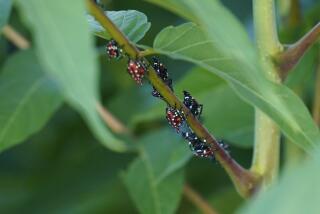Mature Mexican Fruit Fly Discovered in San Ysidro
- Share via
Discovery of a Mexican fruit fly in San Ysidro, the first such find in San Diego County in almost two years, has triggered an intensive effort to learn if a new infestation is imminent.
“A sexually mature, unmated female fly” was discovered Friday in a sapote tree in San Ysidro, according to Kathleen A. Thuner, county agricultural commissioner. “Its discovery and proximity to the international border mean it probably originated either from an infestation in Tijuana or perhaps farther south in Mexico,” she said.
The Mexican fruit fly is a serious problem for farmers throughout Mexico and Texas’ Rio Grande Valley.
The San Ysidro discovery--the first since January, 1985--was followed by an intensive trapping and fruit-cutting effort in the vicinity to determine if the fly is an indication of a new Mexican fruit fly infestation, Thuner said.
“At this time no treatment is planned in San Ysidro,” she said. “Additional traps will be deployed in the area surrounding the find and will be serviced on a daily basis until further notice.”
Mexican fruit fly adults are slightly larger than house fly adults. Their bodies are yellowish brown, and their wings are banded with yellow and brown markings. The female is distinguishable from the male by a long, rear appendage that looks like a stinger but in reality is her ovipositor (egg depositing device). It is used to pierce the skin of fruit to make an opening in which to lay her eggs.
Thuner said a statewide infestation in California would have its greatest impact on the production of citrus, avocados, peaches, pears and other subtropical fruit. It has been estimated that the Mexican fruit fly could cause economic loss of more than $1 million annually for California agriculture, she added.
More to Read
Sign up for Essential California
The most important California stories and recommendations in your inbox every morning.
You may occasionally receive promotional content from the Los Angeles Times.













